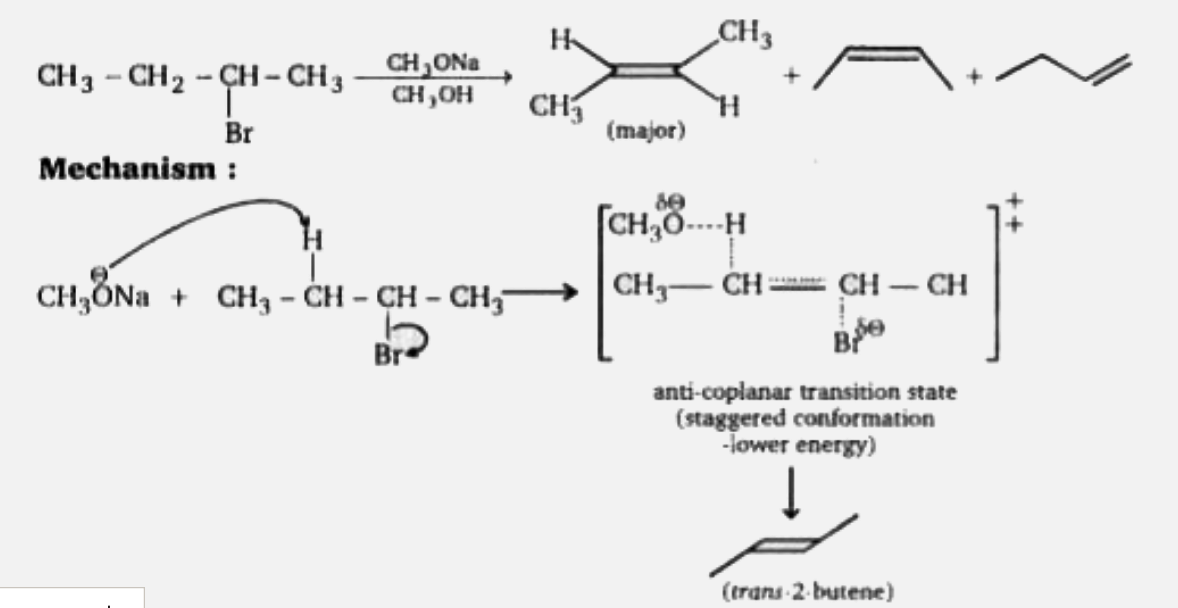What would be the effect of increasing solvent polarity on the rate of each of the following reactions ?
(A) Nu+R−L→⊕Nu−R+L−
(B) R−L⊕→R⊕+L Solution in Telugu
increases
decrease
constant
can not predict
The correct Answer is:A
A-b,B-b In SN2. T. S will be more stable.
Topper's Solved these Questions
- ALKYL HALIDES (SUBSTITUTION REACTIONS)BOOK - MS CHOUHANCHAPTER - ALKYL HALIDES (SUBSTITUTION REACTIONS)EXERCISE - LEVEL-2
41 Videos
- ALKYL HALIDES (ELIMINATION REACTION) BOOK - MS CHOUHANCHAPTER - ALKYL HALIDES (ELIMINATION REACTION) EXERCISE - LEVEL-2
25 Videos
- AMINESBOOK - MS CHOUHANCHAPTER - AMINESEXERCISE - Level-2
1 Videos
Similar Questions
The order of the nucleophilicity of F−,Cl−,Br−andI− in protic solvents is
View SolutionComprehension
E2 raction → Elimination bimolecular
In the general mechanism of the E2 reaction a strong base abstract a proton on a carbon atom adjacent to the one of the leaving group. As the abstracts a proton , a double bond forms and the leaving group leaves.

Identify the rate ofreaction of given compounds in E2 reaction:

View SolutionFive amine syntheses are outlined below. In each reaction box enter a single letter designating the best reagent and conditions selected from the list at the bottom of the page.


View SolutionIn a ABC , If LandM are points on ABandAC respectively such that LMparallel BC
Prove that: ar(LOB)=ar(MOC)
View SolutionR−O∣∣C−O−R'+R''OHH⊕⇐⇒R−O∣∣C−O−R''+R'OH
Above reaction is/an example of :
View Solutionwhat would be the effect of increaing solvent polarity on the rate of each of the following reactions? (Nu = eutral nucleophile)
Nu+R−L→⊕Nu−R+L−
(a) increses (b) decreases (c ) constant (d) can not be predicted
(B) R−L⊕→R⊕+:L
(a) increases (b) decreases (c ) cionstant (d) connot predict
View SolutionR, O, L, I, F, ?
View SolutionIn a cone, (l+r)(l-r) = ………
View SolutionThe mechanism of the reaction : Nu^(-)+R-X to R-Nu+X^(-) is Nu(-)+R-X to [Transition state] (slow) [Transition state] to Nu-R+X^(-) (fast) The rate of reaction can be increased by:
View SolutionIn a △ ABC, If L and M are points on AB and AC respectively such that LM∣∣BC. Prove that: ar (△ LOB)=ar (△ MOC)
View SolutionIf ABCD is a parallelogram, then prove that ar (△ ABD)= ar (△ BCD)= ar (△ ABC)= ar (△ ACD)= 12 ar (parallelogramABCD)
View SolutionIn Figure, ABCD is a parallelogram. O is any point on AC.PQ ||AB and LM||AD. Prove that ar(parallelogramDLOP)= ar (parallellogramBMOQ)
View SolutionIn a ABC, If L and M are points on AB and AC respectively such that LM∣∣BC. Prove that: ar ( LOB)=ar ( MOC).
View Solution(A) : The quantity L/R possesses dimension of time.
(R) : To reduce the rate of increase of current through a solenoid, we should increase the time constant (L/R)
View SolutionReaction R-overset(O)overset(||)C-X + Nu^(-) to R -overset(O)overset(||)C-Nu + X^(-) Is faster while X is
View SolutionR-L, R-L-C परिपथ
View Solution
